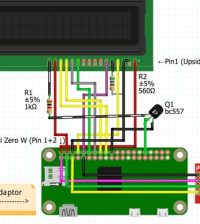- How to Adjust X and Y Axis Scale in Arduino Serial Plotter (No Extra Software Needed)Posted 5 months ago
- Elettronici Entusiasti: Inspiring Makers at Maker Faire Rome 2024Posted 5 months ago
- makeITcircular 2024 content launched – Part of Maker Faire Rome 2024Posted 7 months ago
- Application For Maker Faire Rome 2024: Deadline June 20thPosted 9 months ago
- Building a 3D Digital Clock with ArduinoPosted 1 year ago
- Creating a controller for Minecraft with realistic body movements using ArduinoPosted 1 year ago
- Snowflake with ArduinoPosted 1 year ago
- Holographic Christmas TreePosted 1 year ago
- Segstick: Build Your Own Self-Balancing Vehicle in Just 2 Days with ArduinoPosted 1 year ago
- ZSWatch: An Open-Source Smartwatch Project Based on the Zephyr Operating SystemPosted 1 year ago
Open Building Institute on Kickstarter opens the house source!

The process began in October 2013 with a microhouse—a 144 sq ft tiny house with a loft, a bathroom and a kitchen. To this we then added a bedroom, a mud room, a porch, a library/work space, an office, another bathroom, an utility room, and an aquaponic greenhouse. Together, these structures form a 2000 sq ft living and working space at Factor e Farm (Missouri, USA).
The Open Building Institute is a collaborative effort made possible by the invaluable contribution of volunteer advisors and developers. More than 100 people contributed so far to this incredible open source design project, the initial team is counting open source advisors, scientists, architects, farmers, professors and engineers.
AT THE HEART OF THE PROJECT IS A LIBRARY OF BUILDING MODULES—walls, windows, doors, roof, utility and functional modules, etc.—that can be combined to create a variety of structures: studios, homes, multi-family houses, greenhouses, barns, workshops, schools, offices, etc.
Our approach focuses on state of the art and ecological housing. This means that the system pays special attention to water-catchment, passive heating and cooling, photovoltaics, thermal mass, insulation, off-grid sanitation, and hydronic heat.
Designs and build instructions are contributed by designers around the world and are reviewed by experienced builders. A shared pool of designs means that each one of us does not have to reinvent the wheel. A greater number of designers means faster development. And the larger the number of contributions, the greater the diversity of approaches and solutions we can choose from.
All modules and procedures are OPEN SOURCE—forever and with no exceptions. This means that everyone is free to use, modify and redistribute them. Our OSHWA-compatible license also ensures that you are free to profit from these designs—by using them, for example, in design and/or build contractor work.
The library is made available online in standard CAD formats compatible with open source software applications such as FreeCADand Blender. The library can be directly imported into Sweet Home 3D—an open source interior design application. Once imported into the application, modules can be simply dragged and dropped to create a building design.
The modules on the library are designed specifically to be easily and quickly built by non-professional builders. A 4×8 ft insulated wall module, for example, takes a team of two people 1 hour to build.
THIS OPEN SOURCE AND MODULAR APPROACH TO BUILDING ALSO ALLOWS FOR SOCIAL PRODUCTION.
Throughout several experiments, we learned that it is possible for a group of 35 people to build and install 20 wall modules in 1 day and 6 roof modules in another day. This means that it is possible to build the shell of a 24 x 16 ft structure in 2 days, Building a house may be a labor of love, but it doesn’t have to take a lifetime.
A MODULAR SYSTEM FACILITATES INCREMENTAL BUILDING. Rather than tackling a large project in one go, our approach enables us to start with a small structure—a microhouse, for example—and then keep adding to it throughout subsequent builds. A microhouse, then a bedroom, a mud room, a living room and a greenhouse at last.
If you fall in love with this project as we did, you can contribute in several ways. By designing, spreading the culture, advocate OBI. Or, simpler, to fund them on Kickstarter!
















2 Comments